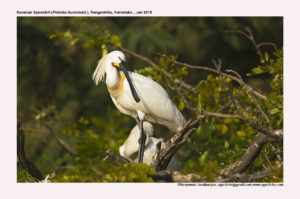Eurasian Spoonbill

Eurasian Spoonbill Platalea leucorodia
Etymology:
- Platalea : Latin word for spoonbill
- Leucorodia : Greek word leukos white ; erodios heron
Vernacular Names: Hindi: Chamach baza, Sans: Shwet aati, Pun: Doi, Ben: Chinta, Khunte bak, Ass: Khantiya bog, Guj: Chamcho, Mar: Eurasian Chamcha, Dabel, Ori: Chamcha baga, Ta: Karandi mooku naarai, Chappai chondan, Te: Gante mukku konga, Teddumooti konga, Mal: Karandikokku, Sinh: Handi alaw
Distribution in India: Resident of West, South and parts of North India.
Description: Size of 80-90 cm ; wt. of 1130–1960 g; wingspan of 115–135 cm.. The male is somewhat larger, with longer bill and legs. The extent of yellow at base of neck is variable, from only small patch in front to complete ring. Non breeding adult lacks yellow and also crest. Immature similar to non-breeding adult, but bill initially pinkish; black tips to primaries.
Habitat:It is found in shallow wetlands; including marshes, rivers, large water bodies and flooded areas. It also uses sheltered maritime habitats, such as deltas, estuaries, tidal creeks and coastal lagoons, particularly in its wintering areas. Nests are frequently placed in dense masses of emergent plants, especially reedbeds, often with scattered bushes or trees.
Food Habits:It eats adults and larvae of water beetles, dragonflies, caddis flies, locusts, flies and other insects; also molluscs, crustaceans, worms, leeches, frogs, tadpoles and small fish; sometimes algae, fragments of aquatic plants and other plant matter. It forages in small flocks, less often alone; wades methodically in shallow water, sweeping bill from side to side; sometimes runs after prey. It is partly a nocturnal feeder. Significance of the shape of the bill is that it serves to minimize drag and turbulence during sweeping, hence not alarming potential prey and that it generates suction effect.
Breeding Habits: They breed in July–Oct in North India and Nov–Jan in South India. They are nest in mono-specific colonies; in mixed colonies shows tendency towards segregation. The nest is a platform of sticks, twigs, reeds or grass stems, lined to varying extent with grass and leaves built on ground or on tufts of grass on islands, in bushes, mangroves or trees. They lay a clutch of 3–4 eggs . The incubation period is 24–25 days. The fledging period is 45–50 days. Males are mainly responsible for nest-building, during daylight they incubate and attend the nest more than females. Females incubate and attend the nest at night and feed the chicks at a higher rate than males. Males thus contribute most to activities that do not require leaving their nests, where all copulations occur.